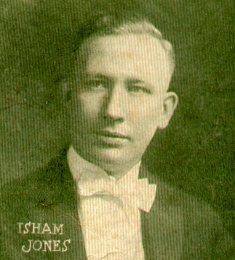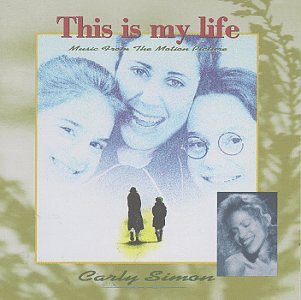
Isham Edgar Jones was an American bandleader, saxophonist, bassist and songwriter.

Bob Loyce Moore was an American session musician, orchestra leader, and double bassist who was a member of the Nashville A-Team during the 1950s and 1960s. He performed on over 17,000 documented recording sessions, backing popular acts such as Elvis Presley and Roy Orbison. Bob was also the father of multi-instrumentalist R. Stevie Moore, who pioneered lo-fi/DIY music. The New York Times called him "an architect of the Nashville Sound of the 1950s and '60s" in his obituary.
"Again" is a popular song with music by Lionel Newman and words by Dorcas Cochran. It first appeared in the film Road House (1948), sung by Ida Lupino. An instrumental rendition was used in the movie Pickup on South Street (1953). By 1949, versions by Vic Damone, Doris Day, Tommy Dorsey, Gordon Jenkins, Vera Lynn, Art Mooney, and Mel Tormé all made the Billboard charts.

This Is My Life (Music from the Motion Picture) is the soundtrack album to the 1992 Nora Ephron film This Is My Life, released by Qwest Records, on April 14, 1992.

The Snow Goose is the third studio album by the band Camel, released in the U.K. on April 25, 1975. The critical success of "The White Rider" suite prompted the group to write more novel-inspired conceptual suites.

The official motion picture soundtrack for The Da Vinci Code with Thomas Bowes (violinist), King's Consort Choir, Hugh Marsh, Orchestra, Richard Harvey, Hila Plitmann, Martin Tillman was released on May 9, 2006 via Decca label. The film's music was composed by Hans Zimmer, whose work resulted in a nomination for the 2007 Golden Globe Award for Best Original Score.
"Midnight Sun" was originally an instrumental composed by Lionel Hampton and Sonny Burke in 1947 and is now considered a jazz standard. Subsequently, Johnny Mercer wrote the words to the song.

Heat is the soundtrack album to the 1995 film Heat. The score is compiled mostly with Elliot Goldenthal's compositions although there are a variety of other artists featured, including U2/Brian Eno project Passengers, Lisa Gerrard, Moby and Terje Rypdal.

Brother Bear: An Original Walt Disney Records Soundtrack is the soundtrack to Disney's 2003 animated feature film Brother Bear. It contains the film's score composed by Mark Mancina and Phil Collins, as well as songs written by Collins, and performed by Tina Turner, The Blind Boys of Alabama, Oren Waters, The Bulgarian Women's Choir, and even Collins himself. Much of the soundtrack in the film consists of the songs performed by Collins as a montage, much like what was done with the earlier Disney soundtrack to film Tarzan, but not entirely. The album was released on October 21, 2003 by Walt Disney Records.
The Charleston Chasers was a studio recording ensemble that recorded music on Columbia Records between 1925 and 1931. They recorded early versions of songs such as "After You've Gone", "Ain't Misbehavin'", and "My Melancholy Baby". Their 1931 recording of "Basin Street Blues" featured Benny Goodman, who stated that it was the first time that he was able to show his own musical personality on record.

Eric Is Here is a 1967 album billed to Eric Burdon & The Animals, although the actual bands with Burdon are the Benny Golson orchestra and the Horace Ott Orchestra.

WALL-E is the soundtrack album to the 2008 Disney-Pixar film of the same name composed and conducted by Thomas Newman. WALL-E is the second Pixar film to be scored by Thomas Newman after Finding Nemo (2003). It was also the second Pixar film not to be scored by Randy Newman or Michael Giacchino. Released by Walt Disney Records on June 24, 2008, it was mainly composed by Thomas Newman and orchestration is credited to Carl Johnson, JAC Redford, Thomas Pasatieri, and Gary K. Thomas. Newman previously scored Finding Nemo and most of all other Pixar films have been scored by either Newman's cousin Randy, Michael Giacchino or Patrick Doyle.

Toy Story is the soundtrack album for the 1995 Disney/Pixar animated film Toy Story, with music composed, conducted, and performed by Randy Newman. The soundtrack includes the film score, as well as three original songs written and performed by Newman. It was released by Walt Disney Records on November 22, 1995, the week of the film's release, and the first soundtrack album from a Pixar film.

Dame Vera Margaret Lynn was an English singer and entertainer whose musical recordings and performances were very popular during World War II. She is honorifically known as the "Forces' Sweetheart", having given outdoor concerts for the troops in Egypt, India and Burma during the war as part of the Entertainments National Service Association (ENSA). The songs most associated with her include "We'll Meet Again", "(There'll Be Bluebirds Over) The White Cliffs of Dover", "A Nightingale Sang in Berkeley Square" and "There'll Always Be an England".
"There'll Be Some Changes Made" ("Changes") is a popular song by Benton Overstreet (composer) and Billy Higgins (lyricist). Published in 1921, the song has flourished in several genres, particularly jazz. The song has endured for as many years as a jazz standard. According to the online The Jazz Discography, "Changes" had been recorded 404 times as of May 2018. The song and its record debut were revolutionary, in that the songwriters (Overstreet and Higgins, the original copyright publisher, Harry Herbert Pace, the vocalist to first record it, the owners of Black Swan, the opera singer for whom the label was named, and the musicians on the recording led by Fletcher Henderson, were all African American. The production is identified by historians as a notable part of the Harlem Renaissance.

Brenda, That's All is the seventh studio album by American singer Brenda Lee. The album was released October 15, 1962 on Decca Records and was produced by Owen Bradley. It was the second of two studio albums released in 1962 and included two Top 10 hit singles on the Billboard Hot 100 between 1962 and 1963.

Road to Bali is a Decca Records studio album by Bing Crosby, Bob Hope and Peggy Lee of songs featured in the film Road to Bali released in 1952. All of the songs were written by Jimmy Van Heusen (music) and Johnny Burke (lyrics). The songs were featured on a 10” vinyl LP numbered DL 5444 and in a 3-disc 45rpm box set numbered 9-375.

Themes and Songs from The Quiet Man is a Decca Records album by Victor Young and Bing Crosby featuring the music used in the Republic Pictures film The Quiet Man. It was issued as a 10” LP with catalog No. DL5411 and as a 4-disc 45rpm set (9–342).
Thomas Vicari is an American recording engineer, mixing engineer, record producer and scoring mixer known for his work with Quincy Jones, Gino Vannelli, Nicholas Britell, Thomas Newman, Prince, George Duke and Barbra Streisand. He was the sound mixer for TV shows and films including Six Feet Under, The Newsroom, Behind the Candelabra, Phantom of the Paradise, Finding Nemo, Finding Dory, Wall-E and Road to Perdition.

"Hymn: Largo cantabile", S. 84/1, sometimes also referred to as "Largo cantabile: Hymn" and often shortened as "Hymn", is a composition by American composer Charles Ives written in 1904. Grouped in the suite A Set of Three Short Pieces, it is published and commonly performed as a standalone work.















